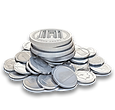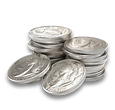🪙 Is Coin Collecting a Hobby or Investment?
- GoldsilverJapan

- Aug 29
- 5 min read
Understanding the Dual Nature of Coins: Passion vs. Profit
Coins are more than shiny metal discs—they’re pieces of history, works of art, and, for many, tools of wealth preservation. But there’s one lingering question people often ask:
“Is coin collecting a hobby or an investment?”
The truth? It can be both—but how you collect makes all the difference. In this in-depth guide, we’ll explore what separates a hobbyist from an investor, what kinds of coins are best suited for each purpose, and how you can strategically enjoy the best of both worlds.
1. What is Coin Collecting?
Coin collecting, known as numismatics, is the practice of collecting and studying coins based on their:
Historical value
Design and artistry
Metal composition (gold, silver, platinum, etc.)
Mintage or rarity
Condition and grading
This passion-driven pursuit can be deeply personal. Some collectors focus on specific eras (like Roman Empire coins), while others pursue modern bullion, mint errors, or world currency sets. But with the rising price of precious metals and inflation concerns, more collectors today are asking whether coins should be part of their investment portfolio.
2. Why People Collect Coins (The Hobby Side)
For many, coin collecting begins with curiosity and beauty, not balance sheets.
🔍 Common Motivations:
Historical fascination – Coins are windows into past civilizations and leaders.
Aesthetic enjoyment – Proof coins and commemoratives are miniature art.
Sentimental value – Inherited collections or coins from travel spark memories.
Challenge and discovery – Completing a mint-mark set or finding a rare variant.
💬 “To me, coins are time travelers. Every one has a story.”
3. Why People Collect Coins (The Investment Side)
On the flip side, there’s a growing audience who see coins as hard assets—a physical way to hedge against risk and grow wealth over time.
📈 Why Invest in Coins?
Inflation Protection – Especially with gold/silver bullion, coins retain value during currency devaluation.
Tangible Asset – Coins aren’t tied to the digital world or financial institutions.
Portfolio Diversification – Coins don't always correlate with stock or bond markets.
Privacy – Physical coins can be owned privately, without third-party custodians.
Crisis Hedge – During geopolitical uncertainty or market crashes, coins often gain value.
4. Bullion Coins: The Investment Core
If your main goal is to protect or grow wealth, bullion coins are your safest entry point.
These are coins made from precious metals (gold, silver, platinum, palladium) and valued mostly for their metal content, not their rarity.
🏅 Popular Bullion Coins:
American Gold Eagle
Canadian Maple Leaf (Gold/Silver)
Austrian Philharmonic
British Britannia
South African Krugerrand
These coins are:
Highly liquid
Globally recognized
Easy to buy/sell based on spot price
⚠️ Be Mindful of Premiums
Bullion coins are sold at a premium above spot price (the current market price of gold or silver). This premium includes minting costs, dealer margin, and demand.
For example:
A 1 oz silver coin might sell for $27 when silver is $23 (a $4 premium).
A 1 oz gold coin could cost $2,100 when gold is $1,950.
🔑 TIP: To reduce premiums:
Buy larger weights (e.g., 100 oz silver bars vs. 1 oz coins)
Avoid fancy packaging or collectible designs
Compare dealers or buy during low-demand periods
But be aware—larger bars = less flexibility when selling. It’s harder to sell a 100 oz silver bar than ten 10 oz bars.
5. Collectible & Numismatic Coins: High Risk, High Reward?
Rare coins can be extremely valuable—but they come with more risk, complexity, and volatility. Their value often depends more on:
Rarity
Condition (grading)
Historical importance
Market demand
Examples:
1909-S VDB Lincoln Cent
1933 Double Eagle (extremely rare and illegal to own in most cases)
1916-D Mercury Dime
1893-S Morgan Dollar
These are not priced based on metal content—they’re priced like art or fine wine, subject to market mood, popularity, and collector trends.
😰 The Risk of Overpaying
If you're not an expert, it's very easy to overpay for rare coins—especially during hype cycles.
Coins like:
Limited-edition Disney silver coins
Star Wars or Marvel-themed rounds
Proof sets from smaller mints
"Reverse proof" and colorized coins
…often carry huge premiums but hold little resale value unless demand skyrockets. They fall under what's called semi-numismatics—blurring the line between collectible and bullion.
🔔 Important Note: These coins are great for collectors but not recommended for stackers or investors. If your goal is wealth preservation, skip semi-numismatics unless you're also a fan.
6. Gold, Silver, or Both?
💛 Gold:
Stable and less volatile
Higher value in smaller volume
Great for portable wealth
🤍 Silver:
More affordable per ounce
More volatile (can spike or crash fast)
Bulky when stacking large amounts
A balanced stack often includes both. Gold for stability, silver for potential upside.
7. How to Tell If You’re a Collector, Investor, or Both
Ask yourself:
Question | Collector | Investor | Both |
Do I care more about design/history than resale? | ✅ | ❌ | ✅ |
Do I track spot prices and premiums? | ❌ | ✅ | ✅ |
Would I sell during a price spike? | ❌ | ✅ | ✅ |
Am I buying for fun, or financial security? | ✅ | ✅ | ✅ |
You don’t have to choose one or the other. Many successful coin enthusiasts build collections they enjoy AND that grow in value.
8. Coins vs. Other Investments (Stocks, ETFs, Real Estate)
Feature | Coins | Stocks/ETFs | Real Estate |
Physical Asset | Yes | No | Yes |
Liquidity | Medium (depends) | High | Low |
Volatility | Medium | High | Medium |
Income Stream | No | Dividends possible | Rental income |
Privacy | High | Low | Low |
Tax Treatment | Capital gains rules | Dividends/taxes | Property taxes |
Bottom line: Coins aren’t income-producing, but they’re excellent for hedging and diversification.
9. How to Start Coin Collecting (Smartly)
Step 1: Define Your Goal
Are you collecting for fun, investment, or both? This will guide what types of coins you buy.
Step 2: Start Simple
Bullion coins from government mints are:
Easy to buy/sell
High purity
Universally recognized
Avoid obscure or flashy coins in the beginning.
Step 3: Learn About Grading
Grading determines a coin’s value. Major services include:
PCGS (Professional Coin Grading Service)
NGC (Numismatic Guaranty Company)
Coins are graded on a 70-point Sheldon scale. A difference of a few points can mean hundreds or thousands of dollars.
Step 4: Watch the Premium
Always compare the price you’re paying to the spot price of the metal. Don’t fall for gimmicks or overpriced packaging.
Step 5: Store Securely
Use:
Coin tubes
Airtight capsules
Fireproof safes
Private vaults (for high-value stacks)
10. Common Questions People Ask
❓ Is coin collecting a good investment in 2025?
Yes—but only if you focus on bullion and key-date coins. Avoid speculative or overhyped pieces.
❓ Should I invest in collectible coins or bullion?
If you're a beginner or stacker, bullion is the best choice. Collectibles require expert knowledge.
❓ Can coin collecting make you rich?
Possibly—but it’s rare. Coins should be viewed as a long-term hedge or store of value, not a get-rich-quick scheme.
❓ What are the risks of investing in coins?
Overpaying due to hype or misinformation
Damage due to improper storage
Buying fakes or replicas
Low liquidity for obscure coins
❓ Are coins better than gold ETFs?
Physical coins offer:
Tangibility
Privacy
No counterparty risk
ETFs offer:
Liquidity
Ease of trading
No storage needed
Many investors hold both.
11. Final Thoughts: The Best of Both Worlds
So, is coin collecting a hobby, an investment, or something in between?
✅ As a hobby, it connects you to history, beauty, and discovery.✅ As an investment, it offers security, privacy, and real asset ownership.
The key is understanding your goals—and buying accordingly.
If you’re stacking, bullion is your best bet. Just watch out for high premiums, and don’t be lured into limited-edition marketing. If you’re chasing rare coins, become a student of the market before diving in. Overpaying for collectibles without expertise is like buying stocks without researching the company.
💡 Gold is measured in karats—but coin knowledge is measured in wisdom.
🧭 Getting Started?
You don’t need to be rich or a historian to begin.
Start with a few silver coins. Learn the basics. Stay curious. And remember—coins are one of the few assets that can make you wealthier and wiser at the same time.











Comments